

























'Investment: Tabitha’s Gown', hand embroidered thread and mirrors on linen; cotton binding and fastening, by Tabitha Moses, Liverpool, England, 2014
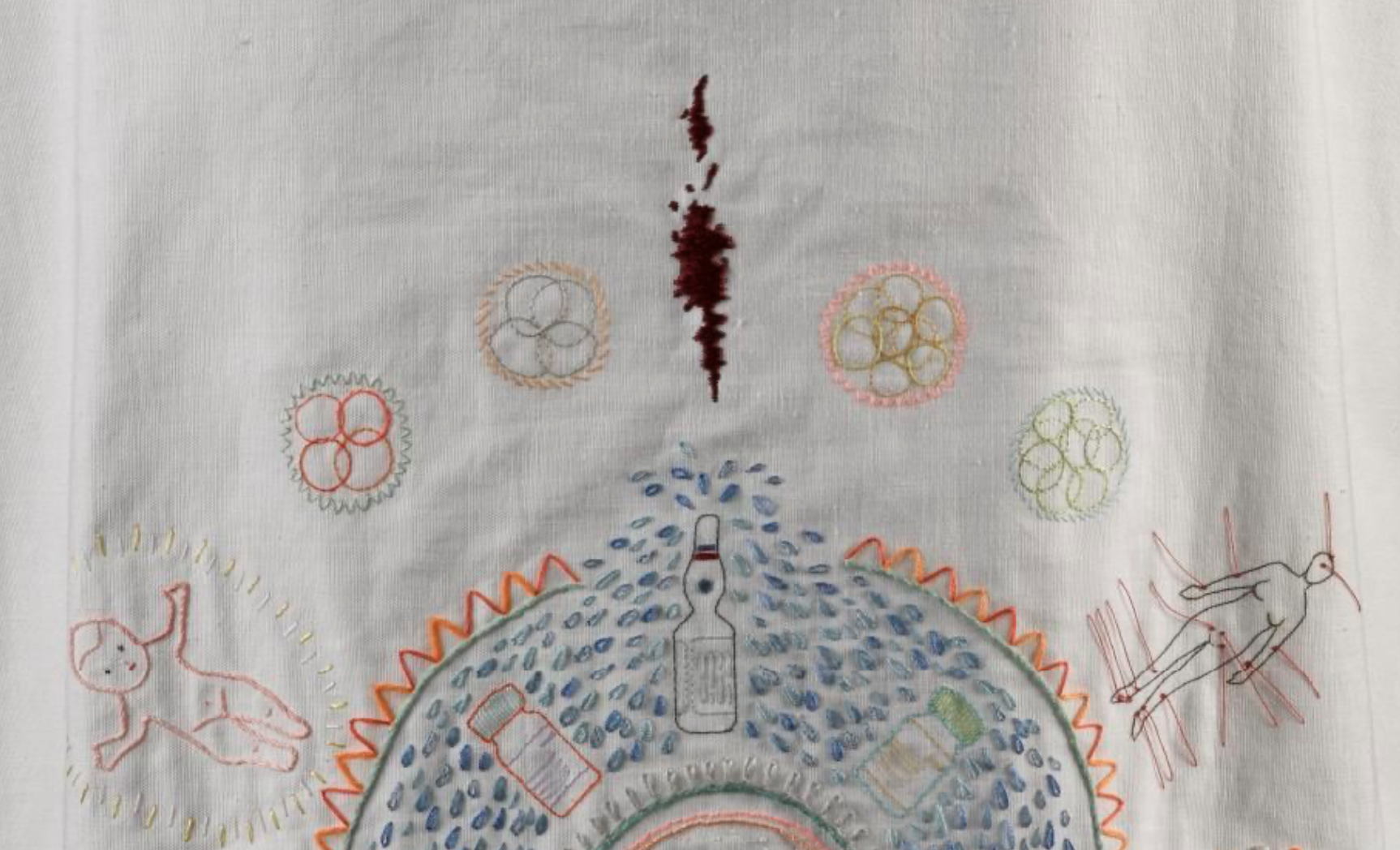
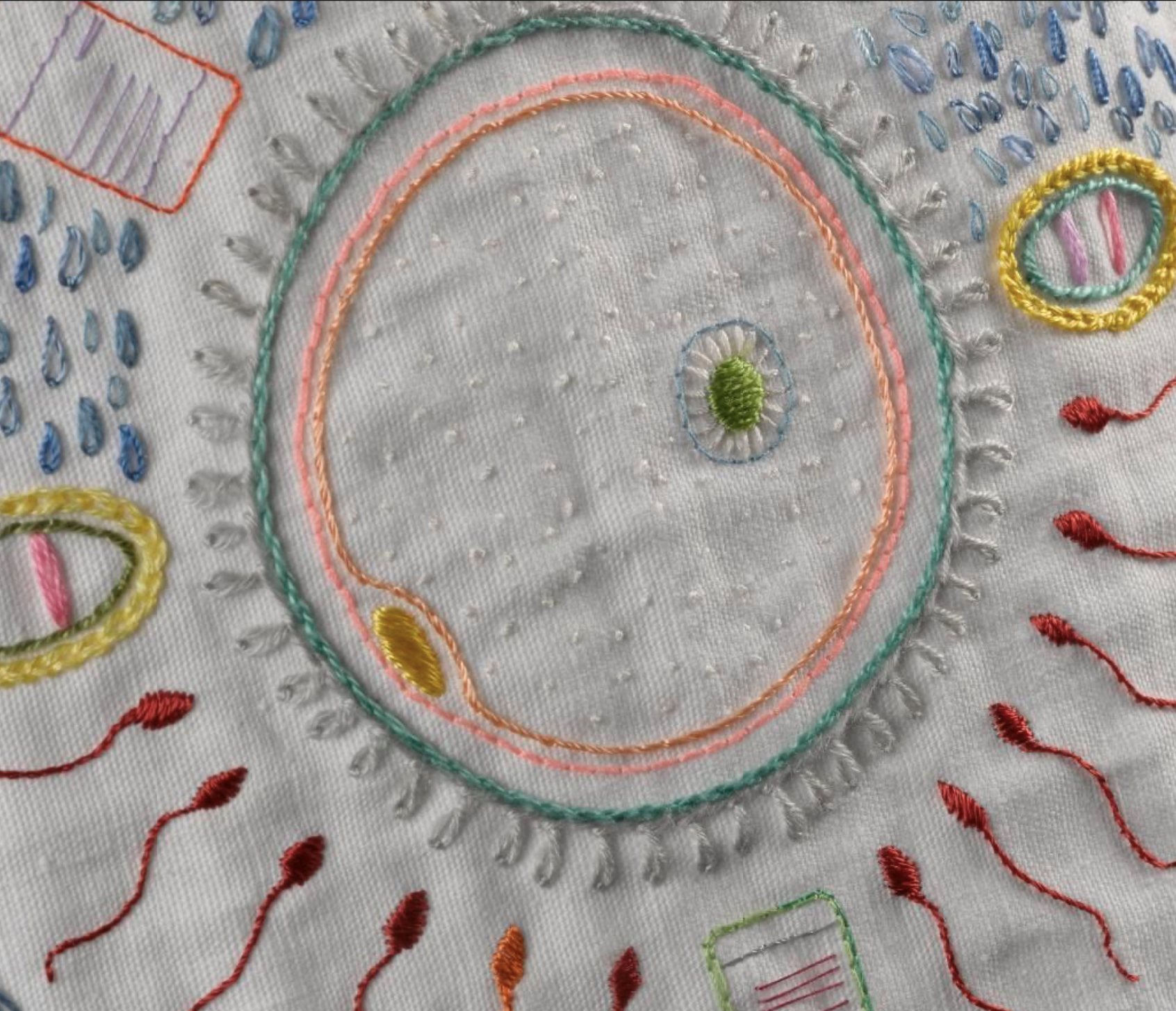

Moses was referred to The Hewitt Fertility Centre at the Women’s Hospital in Liverpool after she and her husband, fellow artist Jim Loftus, spent three years trying to conceive naturally without success. Following a miscarriage and two unsuccessful cycles of IVF using her own eggs, they had a daughter using the eggs of an anonymous donor
In addition to using all the help medical science could offer, Moses found herself gravitating towards alternative therapies and folklore rituals: she had acupuncture, massages and hypnotherapy, and each evening lit a candle in front of a makeshift shrine comprised of a Ghanaian fertility figurine and a baby Jesus figure from a Christmas nativity set. Representing these elements in stitch, ‘Tabitha’s gown’ also shows the clinical paraphernalia of fertility treatment, including a syringe, vials of hormones, pregnancy tests and a thermometer. Four embryos from her unsuccessful cycles are depicted either side of an embroidered bloodstain representing her miscarriage. The central motif is the mature egg awaiting fertilisation
Pioneered in the UK in 1978, in-vitro fertilisation or IVF has given hope to millions of people otherwise unable to conceive. Yet decades later, the process remains physically, emotionally, and financially demanding, and is more likely to fail than succeed
Tabitha’s gown reflects the fact that many of us embrace complementary and alternative medicine, as well as turning to spiritual and emotional sources of support, when facing uncertain medical outcomes. For Moses, making art also provided a means of feeling in control over some part of the process
Sketchbooks

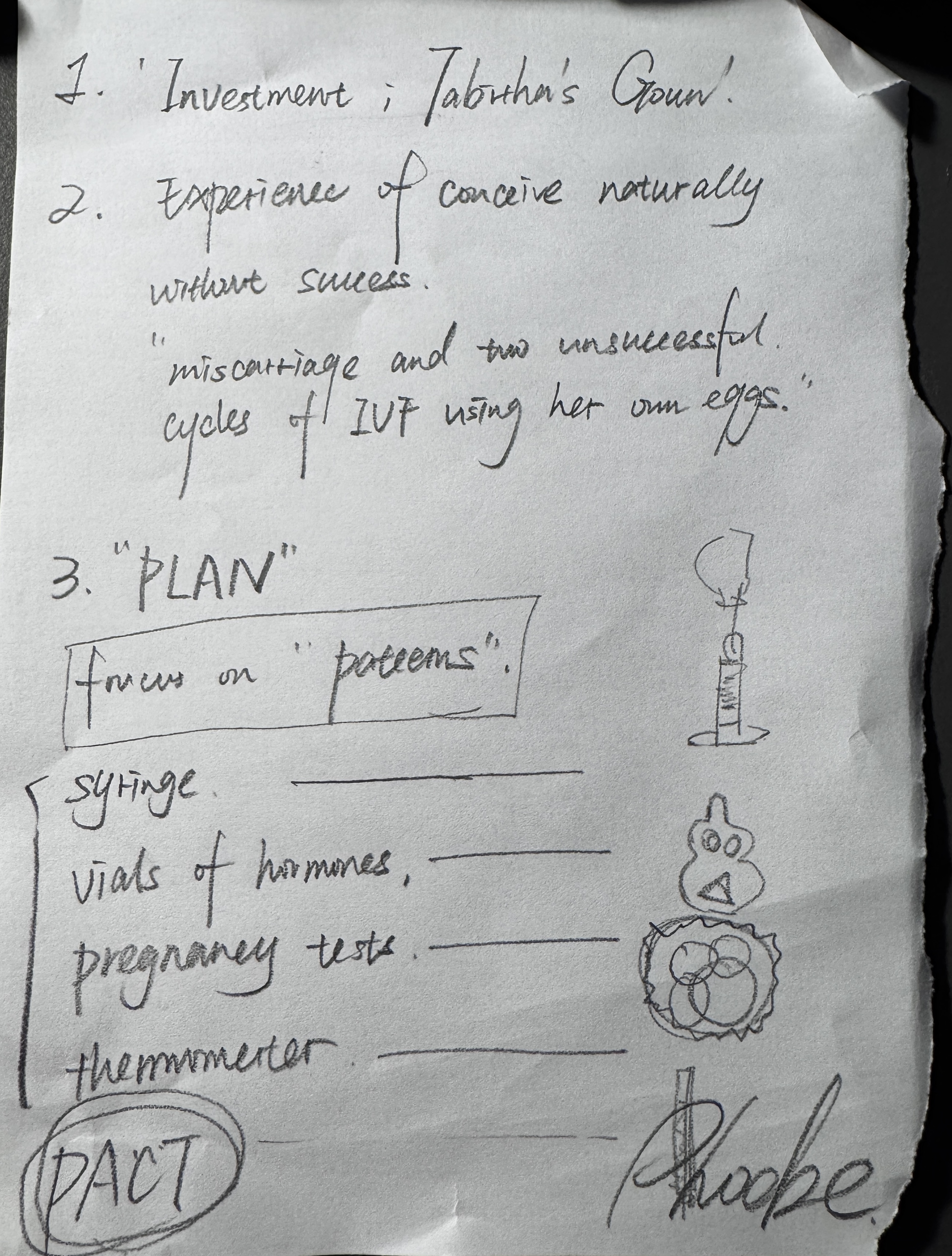
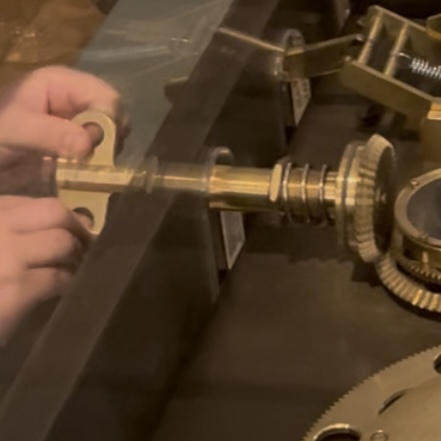
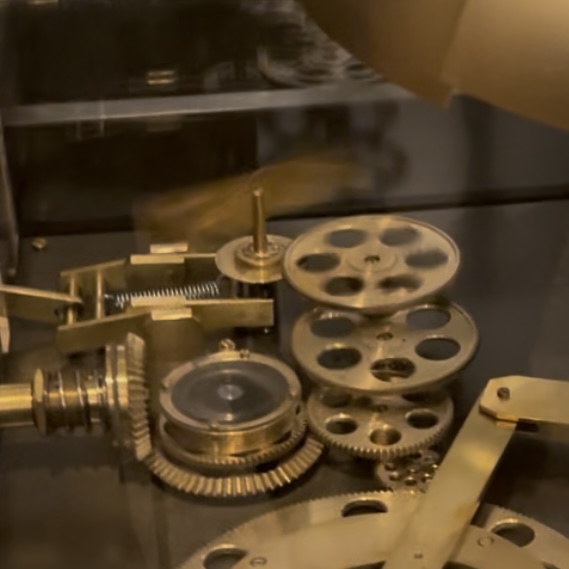
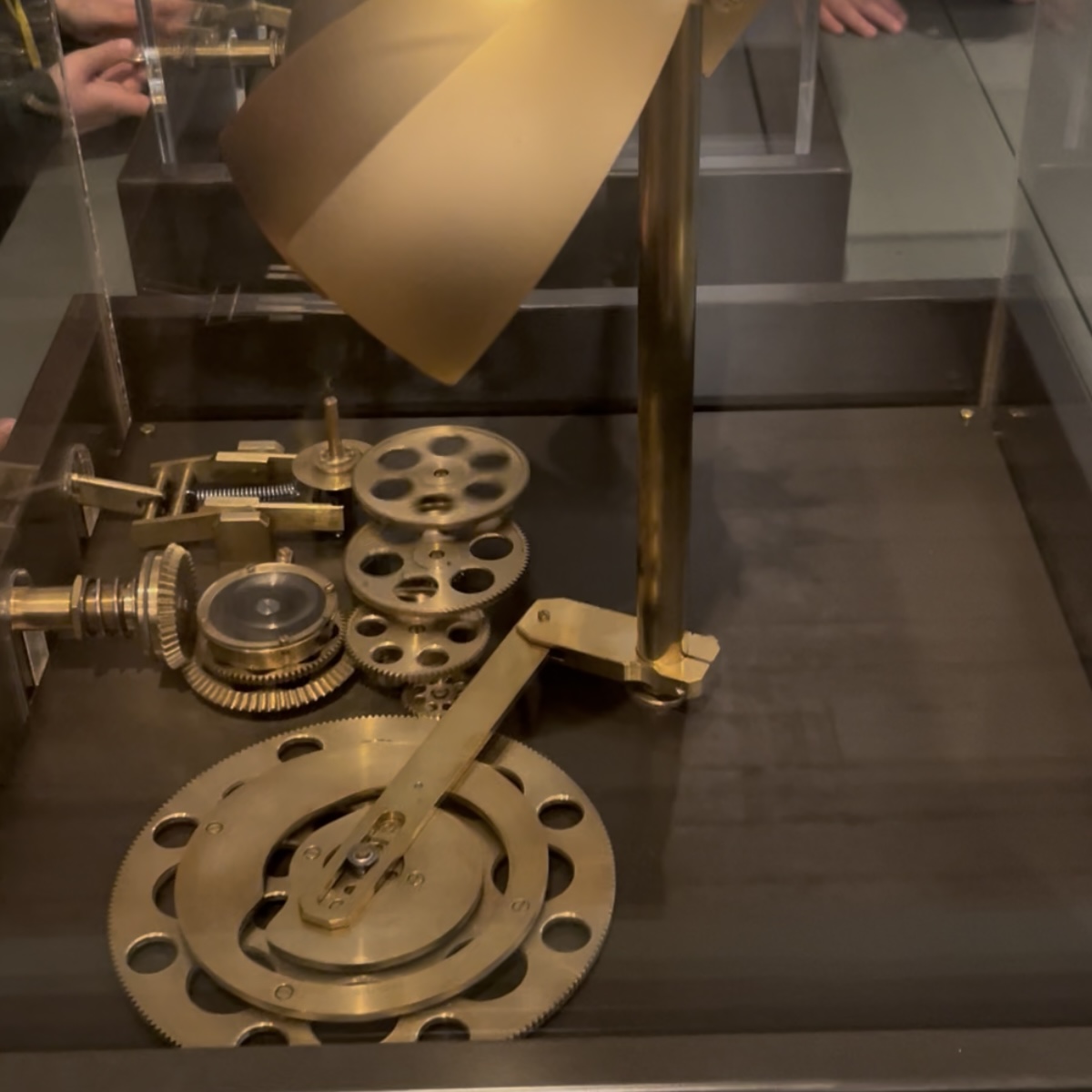
Reflective statement(300 words) :This display features a beautifully crafted mechanical apparatus, composed primarily of polished brass gears, rods, and precision-engineered parts. Its materiality—shiny metals, clean mechanical joints, and a sense of historical craftsmanship—gives it an immediate tactile and visual appeal. The exposed gears invite close inspection, allowing viewers to walk around and appreciate the intricacy of its design from multiple angles. Unlike modern hidden technologies, this display wears its complexity proudly, making the invisible workings of machines visible and understandable
On a personal level, the installation evokes a sense of wonder and respect for the ingenuity of early inventors and engineers. It conveys a message about the beauty of mechanical systems and the human drive to innovate using available materials. The visible effort and elegance in every piece remind me of a time when technology was both a functional tool and a work of art. It suggests a deeper reflection on the relationship between humans and machines — not just using technology but deeply understanding and shaping it
The users of this exhibition space are likely a broad audience: students, families, tourists, and anyone curious about history, engineering, or art. It engages different generations by sparking curiosity, offering tactile learning for younger visitors, and nostalgia or deeper intellectual engagement for adults. The open, interactive layout fosters exploration and personal connection, turning passive observation into active discovery
Self Evaluation / Reflection Form
1. Write a short paragraph highlighting the specific issues and context for your work.
In project one, I created a book and three dynamic posters to explain my theme, “Why We Need to Talk about the Stick Again”, explore its symbolic meaning in culture, mythology and politics, and try to arouse the audience’s attention to the narrative behind it; in project two, I created a sound map, recording the route from my apartment in the center of Nan’an to the port, and used recordings to show the ignored sound layers in the daily environment, so as to arouse people’s re-cognition of place and memory; Project 3 extracts visual symbols from the exhibit “Investment: Tabitha’s Gown”, redesigns them and displays them on the website, exploring the tension between the female identity and social norms carried by the exhibit. Together, the three projects construct my research path to redefine “ignored objects” and try to visualize these narratives through different media.
Media and methods play a core role in my projects, not only as tools to express content, but also as ways to inspire ideas and guide audience participation. In Project 1, books, as a traditional carrier of knowledge, contrast with the modern digital medium of dynamic posters, reinforcing the concept of "dialogue between the past and the present" in the theme. The image superposition and motion path used in the dynamic posters metaphorically reveal the layers of information, echoing the evolution of the "stick" in different contexts. In Project 2, sound, as a non-visual medium, provides the audience with a more immersive and personal sensory experience. Through real recordings of the on-site environment, I explore how places are perceived and remembered through hearing. Project 3 is a digital redesign of the static exhibit symbols. The website becomes a space for these reconstructed images and a virtual exhibition venue. The choice of these methods not only serves the conceptual expression but also reflects my recognition of the theory that "the medium is the message", emphasizing the role of the materiality and form of the media itself in constructing the meaning of the content.
During the creative process, I extensively consulted materials on local memory, material culture and media theory, and was inspired by many artists and theorists. For example, Tim Ingold's research on lines and paths prompted me to think about the path in the sound map project, which is not only a geographical movement, but also a trajectory of time and memory. In addition, the way artist Sophie Calle deals with the relationship between personal narrative and place made me think about how to tell a spatial story through sound. In Project 1, I referred to John Berger's "Ways of Seeing" for its analysis of the relationship between visual symbols and cultural construction, which made me pay more attention to the symbolic meaning of images in dynamic posters. Project 3 was inspired by Barbara Kruger’s combination of text and images. When redesigning the symbols in “Tabitha’s Gown”, I tried to use digital media to give them a new social interpretation. In theory, I was also deeply influenced by Michel de Certeau’s thoughts on “spatial practice”, which made me focus on how individuals “make” meaning in space through behaviour and senses in all my projects, rather than just accepting the established definition of space.
2. Evaluate your work and your progress. Include comments on strengths & weaknesses.
Throughout the project, my greatest strength lies in my ability to dig deep into the subject and present it from multiple angles. Although the three projects are different in form, they all revolve around "memory, place and identity", reflecting my coherence and critical thinking in thematic research. First, in Project 1, I was able to elevate a seemingly simple object "stick" to the level of cultural, political and social symbols, and to interpret it in parallel through two media, books and dynamic posters, which not only improved the project's viewing value, but also enhanced its academic depth. Secondly, Project 2 uses the non-traditional form of sound mapping to express myself, which demonstrates my innovative and experimental spirit in media selection. I was able to use recording technology, spatial walking and sound editing to transform personal experience into public works with emotional resonance. Finally, in Project 3, I visually extracted and redesigned the exhibit "Investment: Tabitha's Gown", which demonstrated my technical ability in image processing, typography and digital presentation, and also showed my sensitivity to gender and power structure issues. In addition, I consulted a lot of literature, theories and art cases during the research stage, and was able to effectively internalize these contents into creative inspiration, which shows that I have a good ability to transform between theory and practice.
Although the overall project has achieved a certain degree of coherence and depth, some deficiencies in methods and execution were exposed during the creative process. First, I had some problems with time management, which resulted in some links, especially the post-editing and presentation links, failing to meet my initial expectations. For example, the sound map of Project 2 was originally planned to be presented in conjunction with an interactive webpage, but due to time constraints, it could only be presented in the form of a static map and audio juxtaposed, lacking the expected interactivity and immersion. Secondly, in terms of visual design, although I have a certain aesthetic judgment and technical foundation, I still need to strengthen the unified style and detail control. For example, the web interface design in Project 3 is a bit bland compared to the content, and the visual hierarchy and user guidance are insufficient, which cannot fully support my conceptual expression of "redesign". In addition, I also tend to be rational in the conception of display strategy, and my emotional expression and narrative are slightly weak. Especially in the sound project, if more first-person narration or interview clips can be added, it may enhance the humanistic care and resonance of the work. Therefore, in future creations, I need to further improve the overall project planning ability, strengthen the integration between media, and at the same time enhance the emotional warmth and appeal of expression.
3. Which aspects of your work would you like to develop further?
After completing the three projects, I hope to further develop my abilities in media integration and interactivity. My current works mainly present the juxtaposition of visuals and sounds. In the future, I hope to use coding and web interactive design to allow the audience to participate in the work in a more active way, thereby enhancing immersion and participation. In addition, I also hope to improve my narrative skills, especially adding more emotional layers to sound projects, such as using first-person narration and interview clips to make abstract concepts more humanistic and resonant. On the technical level, I plan to continue learning web development and sound visualization tools to better support conceptual expression. At the same time, I hope to combine personal experience with broader cultural and social issues to expand the social significance and depth of my work.